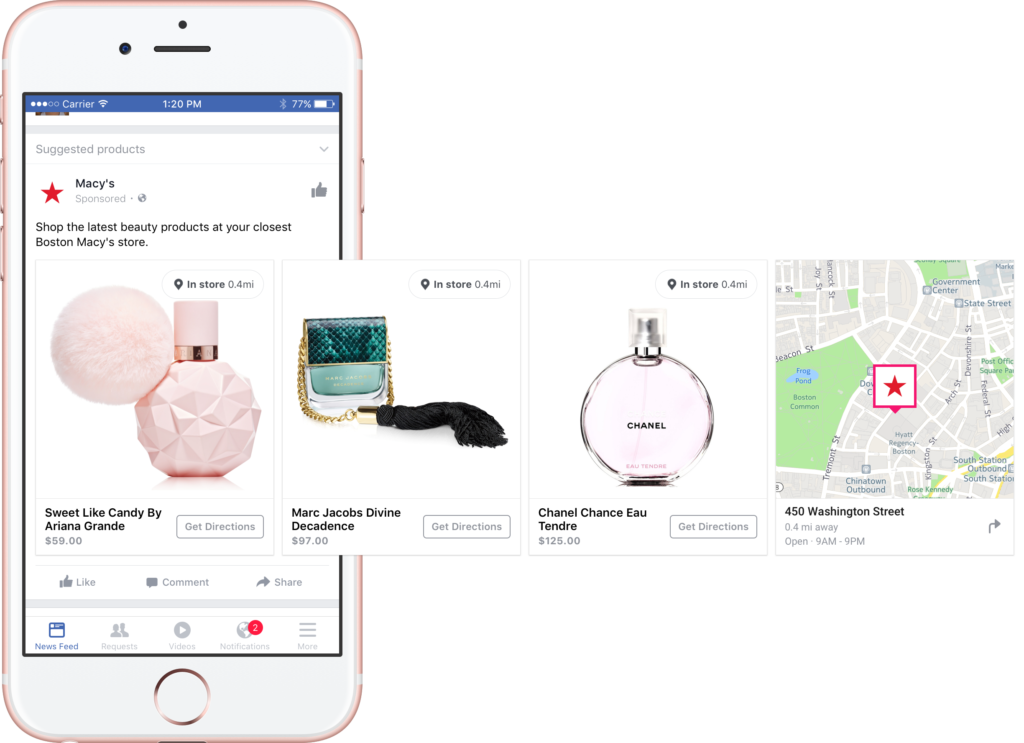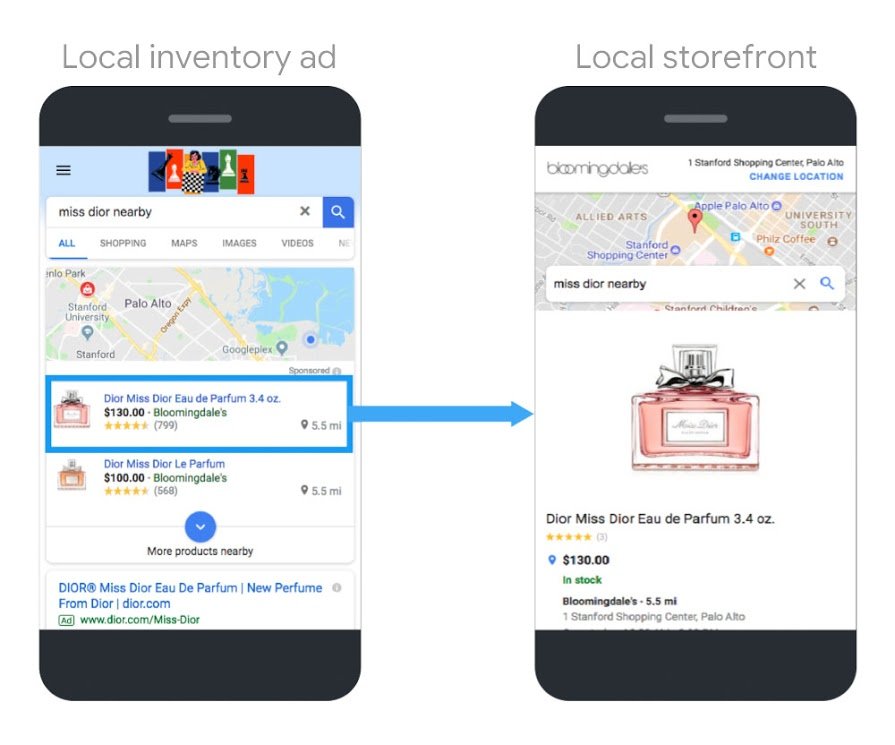The growth of online shopping has had a profound impact on brick-and-mortar retailers. These businesses have been using a mixture of tools to increase in-store traffic and get online shoppers to visit physical locations. With the number of channels and touchpoints increasing each year, marketers are looking for smart marketing tools that add a lot of value without wasting resources. That’s where Google and Facebook Local Inventory ads come in.
Most advertisers are already on Google or Facebook. That means, adding Local Inventory ads (LIA) into their campaign plans is easy and manageable. These ads surface only to users who are both the right audience for the product and in the physical vicinity of a store.
But how can a business know if Local Inventory ads are right for them? Furthermore, which type of ad can help them best reach their goals? Let’s break down the use cases and differences to find out.
Are Local Inventory ads right for your business?
Depending on your industry, audience, or even region, your business may already be rather visible online. However, for companies who are not yet highly digitized, the exact benefits of online advertising for brick-and-mortar can be difficult to understand.
How can these online ads really support the sales and revenue of a physical store? In short: by driving interest and awareness, pushing promotions, and even carefully targeting users with the right products.
Common industries leveraging Local Inventory ads:
- Retailers
- Grocers
- Restaurants
- Automotive dealerships
- Service providers
In short, if you want to drive higher foot traffic and revenue in any of these industries or areas, inventory ads can support your efforts. Next let’s take a look at the different types. We’ll start by breaking down the differences between Google and Facebook Local Inventory ads and see which one best fits your needs.

Facebook Local Inventory ads
Emotional, gorgeous images with great retargeting capacity
Facebook is famous for its Dynamic ads. These ads are able to dynamically pull product details from a product catalog and use that information to automatically populate ads for a specific audience or user. These ads are served to users as they browse and are based on the marketer’s defined targeting plan.
Facebook is also famous for their targeting and retargeting tools. These are central to any successful Local Inventory ads campaign.
| *Note: Facebook does not term their ads as Local Inventory. These ads are achieved through the “store visits” objective, previously through the “reach” objective.* |
Here’s how it works: these ads are much like any other display ad. Marketers can serve ads to users that fit their target audience. This audience will vary depending on the goal of the campaign. For example:
- Retarget warm leads
- Find new leads
- Upsell
- Cross-sell
| Facebook Local Inventory ads at a glance | |
| __Audience__ | Great for retargeting |
| __Creative__ | Use more personalized, emotional, and branded ad creative |
| __Formats available__ | Single image, carousel, video |
| __Appearance__ | Appear in display across Facebook and its channels |
| __Search__ | These do not surface in relation to a specific search |
| __Creation__ | Created using the “Store Visits” objective |
| __Analytics__ | Yes, available through Facebook Ads Manager. See who has visited your stores (with location services enabled) and has engaged with your ads |
| __Features__ | Store Locator (for carousel ads) to direct the user to a physical store |
| Different ads can be shown based on the user's exact location | |
In short: Facebook is great for campaigns of all types, serving leads with branded and diverse imagery to drive both awareness and interest.

Google Local Inventory ads
Practical product ads that pull searchers straight to your shop
Google, on the other hand, serves Local Inventory ads to searchers in the vicinity of a brick-and-mortar location. This a huge distinction from other channels, including Facebook. These ads are not just targeted to users who have displayed some vague interest: they are served to users making searches near or in relation to a brick-and-mortar business.
__Here’s how it works: __when a user googles a product in your inventory, they may be served an ad for the product listed specifically in your store's physical location. Product details as well as distance combine to turn an ordinary Google ad into a highly specific and actionable one. If the user clicks on it, they may be taken to the Local Storefront, where they can learn more about your brick-and-mortar location.
Google’s ads will include a number of set data points about a business like store hours, inventory, promotions, and directions.
| Google Local Inventory Ads at a glance | |
| __Audience__ | Users performing relevant, nearby searches |
| __Creative__ | Does not allow for colorful creative; only use basic product images |
| __Formats available__ | Standard Local Inventory ad (see above) |
| __Appearance__ | Appear in SERP results |
| __Creation__ | Upload extra feeds to Google Merchant Center, Request inventory verification and enable local in your Shopping campaign |
| __Analytics__ | Available through Google Analytics. Includes possibility to combine numerous data points like event, device, geographical location, and others to gain specific insights |
| __Features__ | Digital storefront, making your entire inventory available online |
In short: Google is great for reaching users as they search for relevant products and directing them to a specific physical location, then and there.
Which LIA option will bring you the most foot traffic?
A user googling “shoe stores near me” is a high quality lead. They want you, a physical store, and they’re looking to buy. That is the perfect time to serve them an ad via Google.
However, users that have shown interest in a product, or your particular brand and location, are also strong leads. These users may just need that little extra push to come visit your store. So how do you choose just one ad type?
For most marketers, you can’t choose just one. You'll need a combination of these two ad types to reach users at every stage of the funnel.
| __Google__ | __Facebook__ |
| Reach high-quality leads looking to make a specific purchase | Reach users as they browse online to increase awareness and interest |
| Use high-quality, objective product images | Use emotional, branded images to drive inspiration and interest |
| Grow brick-and-mortar sales | Grow brick-and-mortar sales! |
Shoppers will meet brands at multiple touch points, both physical and digital, before they make a purchase. Start by defining your audience and then planning campaigns for each channel. For both Google and Facebook, it’s easy to set parameters like location (or even time, for Google) so you only advertise to the most relevant user.

![[WP Import] Google vs. Facebook Local Inventory ads: which will drive foot traffic for you?](http://images.ctfassets.net/q17uls4wkkdz/3YqshaSG3DIyjP26kaEKHx/43e2a16b9469e8a74b6037f0b6dc67d8/facebook-local-inventory-ads.jpg?w=1200&h=675&fit=FILL)